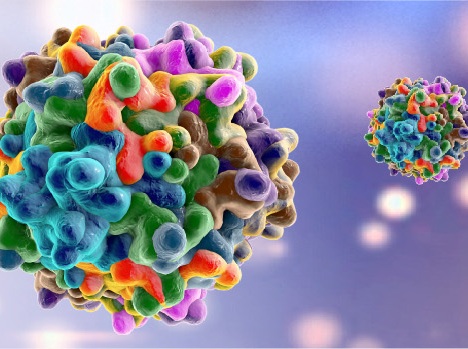Gene therapy can be a promising therapy for both genetic and acquired brain disease. However, the limiting problem in brain gene therapy is delivery to the brain followed by regulation of the expression of the transgene. Present day gene vectors do not cross the blood-brain barrier. Now, researchers from the Broad Institute of MIT and Harvard report they have engineered a gene delivery vehicle that uses a human protein to efficiently cross the blood-brain barrier and deliver a disease-relevant gene to the brain in mice expressing the human protein. Because the vehicle binds to a well-studied protein in the blood-brain barrier, the scientists say it has a good chance of working in patients.
“It it has been tough finding AAVs that worked this well across species,” said Qin Huang, PhD, a co-first author on the study and a senior research scientist in the lab of Ben Deverman, PhD, who helped develop the screening method to find AAVs that bind specific protein targets. “Finding one that works using a human receptor is a big step forward.”
The findings are published in Science “An AAV capsid reprogrammed to bind human transferrin receptor mediates brain-wide gene delivery.”
“Developing vehicles that efficiently deliver genes throughout the human central nervous system (CNS) will broaden the range of treatable genetic diseases. We engineered an adeno-associated virus (AAV) capsid, BI-hTFR1, that binds human transferrin receptor (TfR1), a protein expressed on the blood-brain barrier (BBB).”
To test the AAVs in animals, the researchers used mice in which the mouse gene that encodes the transferrin receptor was replaced with its human equivalent. The team injected the AAVs into the bloodstream of adult mice and found dramatically higher levels of the AAVs in the brain and spinal cord compared to mice without the human transferrin receptor gene, indicating that the receptor was actively ferrying the AAVs across the blood-brain barrier.
The AAVs also showed 40–50 times higher accumulation in brain tissue than AAV9, which is part of an FDA-approved therapy for spinal muscular atrophy in infants but is relatively inefficient at delivering cargo to the adult brain. The new AAVs reached up to 71% of neurons and 92% of astrocytes in different regions of the brain.
In work led by research scientist Jason Wu, PhD, Deverman’s team also used the AAVs to deliver healthy copies of the human GBA1 gene, which is mutated in several neurological conditions. The new AAVs delivered 30 times more copies of the GBA1 gene than AAV9 in mice and were delivered throughout the brain.
The team reported that the new AAVs are ideal for gene therapy because they target a human protein and have similar production and purification yields as AAV9 using scalable manufacturing methods. A biotech company co-founded by Deverman, Apertura Gene Therapy, is already developing new therapies using the AAVs to target the central nervous system.
With further development, the researchers believe it’s possible to improve the gene-delivery efficiency of their AAVs to the central nervous system, decrease their accumulation in the liver, and avoid inactivation by antibodies in some patients.
“When we think about gene therapy for a whole-brain disease like prion disease, you need really systemic delivery and broad biodistribution in order to achieve anything,” said Eric Minikel, PhD, a researcher at the Broad. “Naturally occurring AAVs just aren’t going to get you anywhere. This engineered capsid opens up a world of possibilities.”

Check out our AAV capsid engineering service to expedite your gene therapy research
PackGene Biotech is a world-leading CRO and CDMO, excelling in AAV vectors, mRNA, plasmid DNA, and lentiviral vector solutions. Our comprehensive offerings span from vector design and construction to AAV, lentivirus, and mRNA services. With a sharp focus on early-stage drug discovery, preclinical development, and cell and gene therapy trials, we deliver cost-effective, dependable, and scalable production solutions. Leveraging our groundbreaking π-alpha 293 AAV high-yield platform, we amplify AAV production by up to 10-fold, yielding up to 1e+17vg per batch to meet diverse commercial and clinical project needs. Moreover, our tailored mRNA and LNP products and services cater to every stage of drug and vaccine development, from research to GMP production, providing a seamless, end-to-end solution.
Related News
Skyline Therapeutics Receives FDA Orphan Drug Designation for Gene Therapy for Retinitis Pigmentosa
BOSTON & SHANGHAI, September 2, 2024 – Skyline Therapeutics, a gene therapy company focused on innovative treatments for rare and severe diseases, announced that the U.S. Food and Drug Administration (FDA) has granted Orphan Drug Designation (ODD) for SKG1108....
Novavax Receives Emergency Use Authorization for Updated Covid-19 Vaccine
Novavax has received emergency use authorization (EUA) from the U.S. Food and Drug Administration (FDA) for its updated Covid-19 vaccine, NVX-CoV2705, joining other vaccine manufacturers in addressing evolving virus variants. The EUA permits the use of Novavax's...
Turn Biotechnologies Reports Historic Skin Cell Rejuvenation Breakthroughs at ESDR this Week
Company will present data from its successful rejuvenation of fibroblasts and keratinocytes to influential gathering of international dermatologists MOUNTAIN VIEW, Calif., Sept. 4, 2024 /PRNewswire/ -- Turn Biotechnologies, a developer of novel mRNA medicines and...
H5 influenza vaccines: What needs to be done to reduce the risk of a pandemic
As the global threat of H5N1 influenza looms with outbreaks across species and continents including the U.S., three international vaccine and public health experts say it is time to fully resource and support a robust strategy to address this and future potential...
Related Services

Plasmids GMP Services

AAV GMP Services


